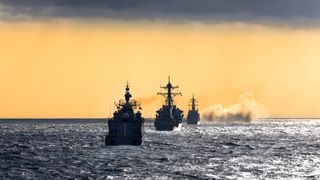This week, Australia is due to play host for the first time to Exercise Malabar, a long-running series of naval drills originally held by India off its coast in conjunction with US forces.
Although not officially a Quad activity, Malabar has effectively functioned as one since Australia rejoined the drills in 2020, following Japan's accession as a permanent partner five years before.
After the disappointment of the last-minute cancellation of May's planned Quad leaders' summit in Sydney amid the US debt limit standoff, hosting Malabar will be ample consolation for Australia.
From an initial focus on building familiarity between participants' navies, these exercises have evolved to focus on increasingly sophisticated forms of high-end naval cooperation, particularly maritime domain awareness and anti-submarine warfare.
It will also present an opportunity for Canberra to advocate taking Quad naval cooperation to a higher level to give the grouping "more muscle" so it can live up to its potential as a regional maritime defence collective.
Fortunately, there is a political and strategic window of opportunity for the four countries to make good on this potential.
Successive leaders' summits and the growing sophistication of the Malabar drills show how the Quad has coalesced around a common strategic logic, with the pursuit of shared maritime security interests and the balancing of China's regional influence as central elements.
Yet conversation about a Quad maritime security agenda is only possible because of the increasingly sophisticated defence cooperation that has been taking place between two or three Quad members at a time.
This shows that an effective Quad maritime security agenda need not look like all four partners doing everything, everywhere, all at once.
This shows that an effective Quad maritime security agenda need not look like all four partners doing everything, everywhere, all at once. Instead, the members can take advantage of naval cooperation already taking place below the Quad level through coordinating operations, standardizing information-sharing procedures and opening more military facilities to one another for maintenance and sustainment purposes.
More effectively aligning these activities would help to amplify measures that the four countries are already taking, both independently and with partners, to respond to Chinese military activities across the Indo-Pacific region.
New developments in the US-Australia alliance could have a big role to play in operationalising this agenda.
Successive joint meetings of Australian and US defence and foreign affairs ministers, in the institutionalised format known as AUSMIN, have demonstrated how the alliance's force posture initiatives, joint exercises and combined military operations are as much about supporting a wider collective defence agenda as they are about supporting the US military presence in Asia alone.
For instance, the joint statement issued after last month's AUSMIN flagged the creation of a maritime domain awareness initiative that will see more frequent rotations of US Navy maritime patrol aircraft through Australian facilities.
The critical inclusion of a reference to "inviting likeminded partners to participate" at a later date suggests that countries like India or Japan, which has already been invited to integrate into US-Australia force posture initiatives, could send aircraft to participate in joint maritime surveillance activities launched from Australian air bases in the near future.
This is exactly the kind of initiative required to advance a strategy of collective defence in Asia.
This is exactly the kind of initiative required to advance a strategy of collective defence in Asia. Yet it is also not entirely groundbreaking, as these activities would fit into a broader tapestry of cooperation that the Quad partners are already undertaking in twos and threes across the region.
India's leadership here deserves special attention, for its activism defies conventional scepticism that New Delhi's preference for nonalignment and its geostrategic priorities militate against deeper military cooperation with its Quad partners.
Evidence from the Indian Ocean tells a different story, showing India leading collective maritime surveillance activities with its Quad partners. Consider a few recent developments.
At the height of India-China border tensions in October 2020, a US maritime patrol aircraft refuelled at Port Blair on India's Andaman and Nicobar Islands at a facility traditionally shielded from foreign access and insight. Japan is helping India to further develop those facilities, and its Maritime Self-Defense Force is paying increasingly frequent visits.
As part of a new enhanced maritime surveillance initiative, Indian and Australian maritime patrol aircraft have also conducted at least four extended visits to one another's naval air facilities for joint exercises and coordinated patrols within the last 18 months. Last month, over 30,000 troops from 13 nations descended on Australia to take part in the country's biennial Talisman Sabre military exercises with the United States.
These activities are great examples of how Quad countries can leverage their strategic geography, military infrastructure and common capabilities to implement a strategy of collective deterrence where and when their political and strategic priorities align.
Formalising US-Australia maritime surveillance cooperation would fit with that agenda, too. Conducting joint or coordinated activities with Quad partners out of Australian facilities would do much to improve the collective picture of Chinese naval activity in littoral Southeast Asia and the eastern Indian Ocean.
To be sure, possibilities for a Quad maritime security agenda are not boundless. Lingering bureaucratic, political and resource constraints across the four member countries will dictate how fast and how far they can move together.
But clearly, progress is being made. The outcomes from this year's AUSMIN demonstrate that bilateral efforts are continuing to open the aperture for tangible Quad maritime defence cooperation.
Rather than through the Quad itself, it is these sorts of developments that will give quiet but valuable expression to Quad naval cooperation beyond the confines of Malabar.






